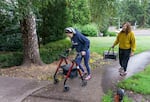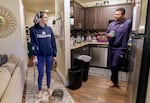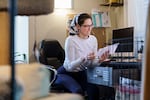
Shelby Boyd takes medication at her home in Lake Oswego, Aug. 11, 2022. Boyd, who had COVID-19 in January 2021, is still enduring blackouts, brain fog and fatigue due to long COVID-19.
Kristyna Wentz-Graff / OPB
Shelby Boyd started blacking out.
All she’d done was stand up, but she was moving too fast. Boyd hunched over, pressing her hands to her knees. She forced slow breaths in and out.
“I’m gonna sit down for just a second, sorry,” she said softly. “Shit.”
Boyd had endured these near-blackouts for more than a year and a half. But despite her dizziness, brain fog and fatigue, she was heading to a new part-time job that day.
She’d made the hard choice to try working again.
Boyd first got COVID-19 in January 2021. She had a relatively mild case and started feeling better after a few weeks. But she recalls waking up in a panic one day, feeling “completely out of my mind.” She became intensely nauseous and lost control of her bowels. She sweated through her sheets night after night.
Her doctor concluded she had long COVID-19. The condition debilitated her for much of that year. She lost her job in sales and marketing. She struggled for months just to get out of bed or to stand without falling. By August 2022, her family badly needed money.
“My accounts are in the negative. I wasn’t able to pay bills and things started getting shut off,” said Boyd, who rents an apartment in Lake Oswego with her husband and two stepchildren. “We were desperate.”
Medical professionals are still learning about long COVID, a range of conditions that can persist months, perhaps even years, after a COVID-19 infection. Symptoms include breathlessness, racing heart, cognitive impairment and profound fatigue. Long COVID can be hard to diagnose and there is no single test for it. In fact, patients may have symptoms that routine medical tests can’t explain.

Shelby Boyd struggles to push her walker up a slight incline, followed by her mother at their apartment complex in Lake Oswego, Aug. 11, 2022. Boyd is one of the thousands of Oregonians who've missed more than one year of work because of long COVID-19.
Kristyna Wentz-Graff / OPB
President Joe Biden recently declared the pandemic over, but the financial pain caused by long COVID is far from through. The condition has forced millions of people, in Oregon and across the country, to make hard, private choices about how to survive on diminished income. And government safety net programs are still coming to terms with the often-baffling new illness.
Nationally, up to four million Americans are out of work due to long COVID, according to a Brookings Institution analysis of experimental Census data this summer. The estimated cost is about $170 billion in lost wages annually.
Researchers Robert Parker and Benjamin Clark from the University of Oregon found about 7% of working-age Oregonians — roughly 185,000 people — had experienced long COVID by spring of this year. That’s cost between $300 million and $1.1 billion in lost wages as of May, the researchers say, not counting replacement income such as paid sick leave or unemployment benefits. Caregivers who missed work to tend to family or friends with long COVID lost almost as much pay as people suffering from the illness.
Regular activities can utterly deplete people with long COVID. “They can experience a crushing sense of fatigue, not so much right afterward, but 12 to 72 hours later,” Eric Herman, a physician who helped lead the creation of Oregon Health & Science University’s long COVID program, told OPB in the spring.
Boyd, an OHSU patient, was so spent by her first week of work that she slept for three days. Exhaustion took a toll on her physical and mental health. One week, she missed four days of work. She was grateful her new boss was understanding.

Shelby Boyd, left, who now uses a cane or walker for support, talks with her husband, James Daniel Boyd III, at their home in Lake Oswego, Aug. 11, 2022. Boyd, who had COVID-19 in January 2021, still suffers from long COVID-19 symptoms, but is trying to work again.
Kristyna Wentz-Graff / OPB
Her husband, James Daniel Boyd III, worried from the day she went back to work. He couldn’t cover the family’s expenses on his job alone. He was painfully aware that they’d maxed out credit cards, spent retirement savings, and even collected cans for change. But he’d watched his wife slowly improve, month by month, and he was scared she’d regress.
“Even though she is sick, she’s ill, she’s disabled — she’s pushing herself to get out and do something that is not gonna allow her to get better,” he said. “Because it’s gonna take longer for her to recover.”
Facing long COVID, debt and hard financial choices
Nurse Kirby Orr’s foster son gleefully launched a bottle of milk from the second floor. It was summer 2022, and the toddler’s nap time was over.

Kirby Orr, left, and her son at their home in Oregon City, Aug. 29, 2022. Long COVID-19 forced Orr to worked reduced hours for roughly one year, resulting in debt.
Kristyna Wentz-Graff / OPB
For many people like Orr, long COVID’s financial impact can’t be measured in lost wages alone. The condition pushed her to take on debt that will take years to pay off.
Orr’s whole family got COVID-19 in December 2020, just as the first health care workers in Oregon were getting vaccinated. Orr was the sole earner, with two nursing jobs. Her wife, Elissa Mantalas, cared for their foster baby and homeschooled her son, who has autism.
Both women developed long COVID symptoms — which is not an unusual occurrence in Oregon families.
In their statewide survey, UO researchers Parker and Clark found that 30% of respondents with long COVID had an immediate family member who’d had the condition too. That could compound many families’ financial stress.
“I had this cough that didn’t go away for like a year and a half,” Orr said.
Orr would wake up at night with her heart racing, a condition known as tachycardia. She’d look at her smart watch: 140 beats per minute. A normal resting heart rate for adults is between 60 and 100 beats per minute. Her oxygen levels would drop. Mantalas got used to the sound of her spouse gagging.
“You know when people are coughing so bad you think they’re like choking or dying?” Mantalas said. “That’s what it sounded like all the time.”
Orr scaled back fast. In early 2021 she stopped working on-call as an acute psychiatric nurse at Providence Portland Medical Center. She was too short of breath to do such a physically demanding job. For about the next year, she kept working part-time in addiction medicine for Kaiser Permanente Northwest.
The couple couldn’t afford the drastic income cut — not with van payments to make, kids to feed, and rent to pay on their Oregon City house. They ran up credit cards, but that was a high-interest trap.
Ultimately, they took out $50,000 in loans. They paid off some debt right away.
Orr felt fortunate to qualify for the loans. Other people with long COVID who were interviewed for this story couldn’t get personal loans, because they’d lost any income to anchor them.
As the months passed, things slowly improved. Roughly a year into long COVID, Orr transitioned to a full-time job at Kaiser. A year and a half after catching the coronavirus, doctors got her cough under control. In late August, she and Mantalas adopted their lively son. They pay more than $800 on the long COVID loans each month. Pretty soon, their student loan payments will resume too.
“I guess I just don’t want it to seem like, ‘Oh poor us,’ because I think we’re very lucky. And also, now we’re in a lot of debt,” Orr said. “Which still sucks, right? Like, it still sucks.”
Long COVID is hurting long-term employment prospects
It’s unclear how big a role long COVID has played in Oregon’s labor shortage. Parker and Clark’s study found half of Oregonians with long COVID hadn’t missed any work, but the other half did — from a few days to nearly two years. Between 10,000 and 30,000 people had already missed more than a year of work by spring 2022.
Child welfare worker Kristina Hunter is one of them.
Hunter faces a financial tradeoff familiar to people benched by extended struggles with long COVID. Some have to give up their former jobs and pay in order to find work they can still do. Long COVID is re-writing their long-term employment prospects.
Hunter, who lives in Lincoln City, has barely worked since March 2020, when she thinks she first got COVID. She is currently on leave from the Oregon Department of Human Services, her employer since 1998.
Hunter believes she’s had COVID several times. She’s suffered intense and recurring symptoms, including nausea, vertigo, headaches and severe body pain. By spring 2021, records show, her doctor had diagnosed Hunter as having long COVID with chronic fatigue. Hunter has a history of health challenges, but she’s struggled with how constant and debilitating long COVID feels.
“You don’t see an end,” she said, her voice breaking up on the phone.
“You don’t know how long it’s going to take for you to get better.”
The Biden administration in August reaffirmed that long COVID may qualify as a disability under the Americans with Disabilities Act and other laws. When it does qualify, employees are generally entitled to a reasonable accommodation at work — a crucial job protection. For example, a person whose long COVID causes fatigue may be able to work flexible hours.
“We’ve also seen the challenges, too, with employers,” Herman, the OHSU doctor, told OPB earlier this year. “As they try to make accommodations, some are more supportive of their employees, others can present more barriers for them.”
Low-wage workers who live paycheck-to-paycheck may have the hardest time accessing workplace accommodations. “Low-wage jobs tend to be physically demanding, inflexible when it comes to hours, and ineligible for remote work,” wrote Katie Bach, the author of the Brookings paper on long COVID.
As for Hunter, her doctor recently cleared her to go back to work, with restrictions — she’d have to work from home and start out part-time. But Hunter can’t do essential parts of her job from home, such as visiting vulnerable children. She said her agency is looking at alternative jobs for her but they pay less.
“I’ll most likely have to take a demotion,” Hunter said, “because I’m not able to perform the duties of the job that I had.”
The Department of Human Services said it couldn’t confirm or comment on specific ADA requests, to protect employee privacy. The agency said it was committed to trying to provide reasonable accommodations for people with disabilities, including those caused by long COVID. It also said it would consider reassignment — preferably a lateral transfer but possibly a voluntary demotion — if an employee can no longer perform the essential functions of their job.
Hunter said she’s exhausted her savings. She’s taken out multiple credit cards and owes thousands of dollars on them. She’s relying on her mother to pay the mortgage. She wants to work again, but is scared that working part-time at a lower-wage job won’t dig her out of the long COVID hole.
“That’s going to be another real hardship,” she said, “when I have to take a permanent pay decrease.”
Disability benefits, the final safety net
Shelby Boyd avoided the letter. She stuck it in a pile of mail, unopened, for days.

Shelby Boyd sorts through bills at her home in Lake Oswego, Aug. 11, 2022. Long COVID-19 has been a financial blow. “My accounts are in the negative. I wasn’t able to pay bills and things started getting shut off,” she said.
Kristyna Wentz-Graff / OPB
She’d been expecting the Social Security Administration to deny her application for the federal disability benefits known as Supplemental Security Income. That expectation was partly why, despite her symptoms, she was pushing herself to work again.
When Boyd finally ripped open the envelope, she read aloud.
“Based on a review of your health problems, you do not qualify for SSI payments on this claim,” she said. “This is because you are not disabled or blind under our rules.”
Boyd lowered the paper.
“That is insane,” she said. “There’s truth and then there’s not truth. The truth is that I am as ill as I am. I am as ill as my medical teams are saying I am.”
Federal disability benefits are a final safety net for people who say long COVID has made them too sick to work. But reports suggest some long COVID patients around the country are struggling to get them. Social Security disability lawyers in Oregon say it’s still too early to know, but they expect clients with long COVID will face challenges. To get disability benefits, for example, a person’s severe impairment has to be expected to last for 12 months in a row, which could be hard to demonstrate with long COVID.

Ashley Mahan has been denied twice so far for Social Security disability benefits. Mahan, with her daughter Marina Bermudez, 14, moved in with an elderly friend in Corvallis after she developed long COVID-19 in 2020.
Kristyna Wentz-Graff / OPB
Boyd’s friend Ashley Mahan has been denied twice so far. The two women met and bonded during a virtual therapy group for long COVID patients at OHSU.
After Mahan developed long COVID in 2020, she needed a place to stay for free. She and her daughter moved in with an elderly friend in Corvallis, in exchange for helping out. On good days, she putters around the yard. On bad days, she disappears into her room.
“Nothing is like I was. I’ll never be like I was,” she said.
Like many long COVID patients, Mahan has brain fog — a term for cognitive impairment. She gets confused and forgetful. She’s blanked out while driving. Was she on a two-lane road or heading the wrong way down a one-way street?
Mahan appealed when her application for disability benefits was denied a second time. Her lawyer, Brent Wells of Wells, Manning, Eitenmiller & Taylor, said Mahan is his first long COVID client to go before a Social Security judge. The Social Security Administration said it has received about 40,000 disability claims nationally that mention COVID-19, but it would not say how many it has approved.
At a March hearing, Mahan’s judge postponed the proceedings for six more months, so he could call an expert medical witness.

Ashley Mahan, right, looks over her medications at her Corvallis home, Aug. 12, 2022, as her daughter Marina Bermudez, 14, looks on. "The only way I can semi-function," Mahan said, "is with five medications or more."
Kristyna Wentz-Graff / OPB
That shows, Wells said, how unfamiliar the Social Security system is with long COVID as a disabling condition. It’s a system that relies on objective medical evidence, such as tests or medical imaging, to prevent fraud.
“Many long COVID symptoms aren’t capable of objective verification,” Wells said. There is no X-ray for fatigue.
Mahan’s second hearing was last month. It didn’t appear to go well for her. The expert witness lacked knowledge about long COVID, according to Wells and Mahan.
“Let’s just wait and see,” she said.
Disability payments wouldn’t be a lot of money, Mahan said. But they could buy her time.
“It would be enough to keep me from ever being homeless,” she said. “It’s just that safety net. I have to give my brain a long time to heal.”
